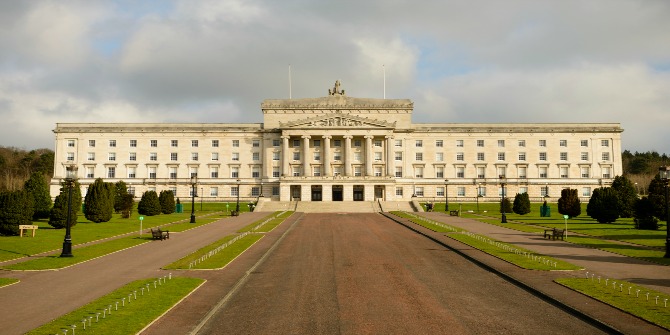 Labour’s predicament is difficult, but it is the Liberal Democrats who face an existential crisis. What then should the Lib Dems do next? The overriding priority must be to restore trust in the party, writes Peter Sloman.
Labour’s predicament is difficult, but it is the Liberal Democrats who face an existential crisis. What then should the Lib Dems do next? The overriding priority must be to restore trust in the party, writes Peter Sloman.
The general election results marked a damaging setback for Labour and a brutal defeat for the Liberal Democrats. In 2010, patterns of tactical voting which had built up over twenty years helped both parties retain enough marginals to deny David Cameron a majority. This time round, the firewall disintegrated. Labour made a net gain of just two from the Conservatives, whilst the Liberal Democrats collapsed in suburban England and their south-western heartlands as the centre-left vote fragmented and centre-right voters moved over to the Tories. The SNP landslide in Scotland completed the rout.
It was difficult for both parties to fight against the ‘fear factor’ whipped up by the press and the huge amount of direct mail which the Conservatives poured into target seats, but there were also significant self-inflicted wounds. Not only did the Liberal Democrats alienate left-leaning voters by entering the coalition, but its leaders did as much as David Cameron and George Osborne to brand Labour as spendthrift and irresponsible – Nick Clegg by playing up the comparison between the UK and Greece, David Laws by brandishing the now-notorious note from Liam Byrne. By crediting the Tories with a ‘head’ and Labour with a ‘heart’, the party’s election campaign stoked fears of Labour and helped drive swing voters to the Conservatives. Worse, Nick Clegg’s insistence that a hung parliament was inevitable – in line with the pundits and the published polls – fostered complacency on the left and exacerbated tactical unwind.
To be fair, the Labour campaign was not much more inspiring. For all Ed Miliband’s talk of restructuring the British economy and creating a responsible capitalism, the party’s position on the core issue of the deficit was dangerously muddled: after three years of opposing ‘austerity’, the Labour leadership spent the run-up to the election trying to minimise its differences with the government. Miliband’s positive offer – on zero-hours contracts, energy prices, non-doms, and the bedroom tax – was worthy but narrowly economistic, and allowed the party to be backed into exactly the trap that Gregg McClymont and Ben Jackson warned about in 2011: defending a minority of losers from Conservative government without persuading swing voters that it offered a credible alternative. Wider progressive issues such as the environment, civil liberties, internationalism, and constitutional reform barely featured at all. Where Jon Cruddas had spoken of a crusade for ‘national renewal’, Miliband offered ‘an economy that works for working people’ – the kind of labourist slogan that hasn’t resonated with voters since 1974. No wonder the party made so little progress with Middle England.
After five years of coalition, last Thursday’s results remind us how far Labour and the Liberal Democrats’ fortunes are co-dependent – and their attacks on each other self-defeating. With the SNP rampant in Scotland and boundary changes in the pipeline, it’s difficult to see how Labour can become the largest party again without the Liberal Democrats regaining seats from the Conservatives – and equally hard to see how that can happen so long as middle-class voters fear a Labour government.
Labour’s predicament is difficult, but it is the Liberal Democrats who face an existential crisis. It is true that this is the fourth time since the Second World War that the party has been down and out, and on each occasion – after 1951, 1970, and 1988 – it has come back stronger. This time round, though, the Liberal Democrats face two additional handicaps. Firstly, the rise of the SNP, UKIP, and the Greens has created a crowded political landscape, so the party will have to fight much harder to get its voice heard. Secondly, the party can no longer rely on a sympathetic reception from voters in the way that it was once able to. Memories of the coalition will take some time to fade, especially on the left.
What, then, should the Liberal Democrats do? The overriding priority must be to restore trust in the party – the sense that it is not only working for voters but with them, and prepared to take them into its confidence. As I’ve argued elsewhere, the post-war Liberal revival was founded as much on the party’s reputation as ‘honest outsiders’ as it was on left-right positioning. Of the two main leadership contenders, Tim Farron is likely to find it easier to revive this reputation, because he voted against the 2011 increase in tuition fees. The party’s Scottish and Welsh leaders, Willie Rennie and Kirsty Williams, and the influential blogger Stephen Tall have already endorsed him.
As David Howarth, the former Liberal Democrat MP for Cambridge, has argued, the party also needs to start talking more explicitly about its values:
“Parties that define themselves around collective interests (for example classes and nations) can afford to be vague about their political values – which both Labour and the SNP are. But we can’t be vague. Some of our values are clear – internationalism, protecting individuality and non-conformity, hating bullying and the abuse of power, promoting environmentalism, protecting civil liberties and a love of democracy not so much because we think it efficient or effective but because it expresses a basic equality of respect for all individuals. But some of our values are not clear. Most significantly, what is our view of economic inequality?”
If the party’s egalitarian streak has been submerged during the Clegg years, it seems likely to come to the fore again under a Farron leadership. The former party president used his Beveridge lecture to last year’s Social Liberal Forum conference to argue that the ‘post 1979 consensus’ had failed and that Britain needed ‘active, ambitious liberal government’ to tackle poverty, climate change, and the housing crisis. That may well be the best position from which to oppose a majority Conservative government. There is certainly little evidence that soft Tories have been impressed by the small-state liberalism of the party’s Orange Book wing.
Whoever takes over the leadership from Nick Clegg, it is bound to be a long road back. Half a century of hard-won gains – at both local and parliamentary level – have been wiped out in five years, and by 2020 the Liberal Democrats will be up against well-entrenched Conservative incumbents in most of their target seats. Campaign techniques honed in the 1970s and 1980s also need refreshing. On the other hand, the party has fallen so far since 2010 that it can reasonably hope for gains in the Scottish Parliament and Welsh Assembly elections next year and the county council elections in 2017. It has also added over 10,000 new members since polling day, partly reversing the decline it suffered in the early years of coalition. Perhaps there is some life in the old bird yet.
Note: This article gives the views of the author, and not the position of the British Politics and Policy blog, nor of the London School of Economics. Please read our comments policy before posting.
 Peter Sloman is a Junior Research Fellow at New College, Oxford, and the author of The Liberal Party and the Economy, 1929-1964 (Oxford University Press, 2015).
Peter Sloman is a Junior Research Fellow at New College, Oxford, and the author of The Liberal Party and the Economy, 1929-1964 (Oxford University Press, 2015).








The Lib Dems stand for a number of things no other party is willing to represent particularly forcefully: genuine social liberalism (e.g. reforming drug laws); openly pro-immigration/Europe views; federalism; electoral reform. These are issues that the other parties either disagree with or shy away from because they’re trying to chase the centrist vote so if the Lib Dems staked out that territory they’d have a consistent support base. In theory they already support these things, they just downplayed them during the 2015 election because they were trying to go for damage limitation.
I think this government is going to become unpopular very quickly just as John Major’s government did after his surprise ‘victory’ in the 1992 general election. The Tories done well in the local elections of 1992 and then lost every County Council they controlled (except for true blue Buckinghamshire) in 1993. The Lib Dems need to articulate what only they really stand for ie constitutional reform and electoral reform in particular. It really is time the disgracefully undemocratic FPTP which has produced some very perverse and unfair outcomes this general election was done away with. It would help the movement to change this system if the Lib Dems weren’t so wedded to the Single Transferable Vote system. Perhaps, if the Lib Dems changed their stance to just supporting a proportional system in general then people who support electoral reform would be more willling to vote Lib Dem?
It probably depends at least in part on how unpopular and how quickly the Conservatives become. Also if we can position ourselves as the recipient of this hostility. We also need a change to our electoral system and possibly some sort of pact with the other opposition parties.